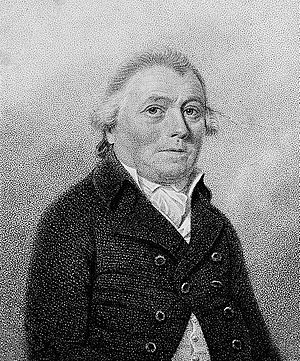William Forsyth (horticulturist) facts for kids
Quick facts for kids
William Forsyth
|
|
|---|---|

A stipple engraving of William Forsyth
|
|
| Born | 1737 Oldmeldrum, Aberdeenshire, Scotland
|
| Died | 25 July 1804 (aged 66–67) |
| Occupation | Botanist |
William Forsyth (1737 – 25 July 1804) was a Scottish botanist. A botanist is a scientist who studies plants. He was a very important gardener for the King and Queen of England. He also helped start the Royal Horticultural Society, which is a famous group that promotes gardening. A beautiful flowering plant called Forsythia is named after him!
Contents
Life as a Royal Gardener
William Forsyth was born in a place called Oldmeldrum in Scotland in 1737. He learned how to be a gardener at the Chelsea Physic Garden in London. His teacher was the main gardener there, Philip Miller.
Becoming Chief Gardener
In 1771, William Forsyth became the chief gardener at the Chelsea Physic Garden. He was a mentor to other young gardeners, like John Fraser. Later, in 1784, he got an even bigger job. He became the superintendent of the royal gardens. These gardens were at Kensington and St James's Palace. He kept this important job until he passed away.
Creating a Rock Garden
In 1774, while he was in charge at the Chelsea Physic Garden, William Forsyth made one of the first rock gardens. He used about 40 tons of different stones for it. Some stones came from roadsides near the Tower of London. He also used flint and chalk from nearby hills. Plus, he added some pieces of lava from Iceland. Even with all these cool rocks, the garden didn't grow much!
Forsyth's Tree "Plaister"
William Forsyth was always looking for ways to help plants. In 1798, he created a special mix he called a "plaister." It was made from things like lime, cow dung, ashes, and even urine. He said this mix could fix problems in trees. He claimed it could heal trees even when only the bark was left.
The British government was very interested in his plaister. In 1799, they gave him £1,500 to keep working on it. This was because the country was at war and needed strong wood to build ships. The royal forests, which provided wood, were not in good shape. Forsyth's plaister was hoped to make the trees healthier.
His Published Works
William Forsyth wrote books to share his gardening knowledge.
- Observations on the Diseases, Defects, and Injuries in All Kinds of Fruit and Forest Trees (1791)
- A Treatise on the Culture and Management of Fruit Trees (1802)

